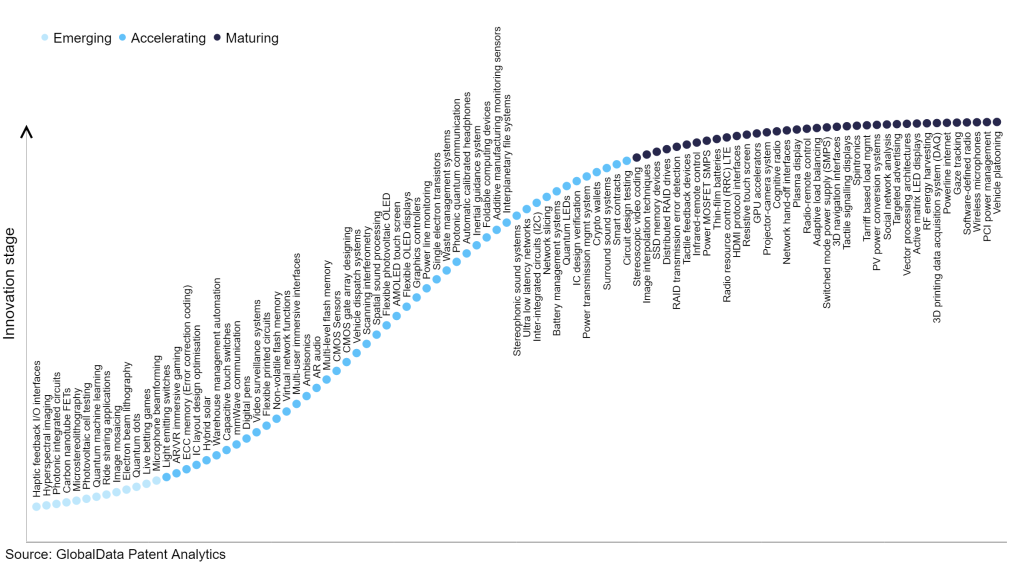The technology industry continues to be a hotbed of innovation, with activity driven by the increasing demand for high-performance computing, the need for faster data processing, advancements in semiconductor technology, and growing importance of technologies such as specialized vector processing units, advanced instruction sets, memory systems optimized for vector operations, and software tools for vectorization and parallel programming. In the last three years alone, there have been over 3.6 million patents filed and granted in the technology industry, according to GlobalData’s report on Technology Innovation: Vector processing architectures. Buy the report here.
However, not all innovations are equal and nor do they follow a constant upward trend. Instead, their evolution takes the form of an S-shaped curve that reflects their typical lifecycle from early emergence to accelerating adoption, before finally stabilising and reaching maturity.
Identifying where a particular innovation is on this journey, especially those that are in the emerging and accelerating stages, is essential for understanding their current level of adoption and the likely future trajectory and impact they will have.
300+ innovations will shape the technology industry
According to GlobalData’s Technology Foresights, which plots the S-curve for the technology industry using innovation intensity models built on over 2.5 million patents, there are 300+ innovation areas that will shape the future of the industry.
Within the emerging innovation stage, microphone beamforming, live betting games, and quantum dots are disruptive technologies that are in the early stages of application and should be tracked closely. Circuit design testing, smart contracts, and surround sound systems are some of the accelerating innovation areas, where adoption has been steadily increasing. Among maturing innovation areas are, vehicle platooning, Peripheral Component Interconnect (PCI) power management, and wireless microphones, which are now well established in the industry.
Innovation S-curve for the technology industry

Vector processing architectures is a key innovation area in technology
Vector processing architectures are computer architectures specifically designed to process vast quantities of data simultaneously using vector processors. They are commonly utilized in high-performance applications, particularly in scientific and engineering domains. By employing a single instruction to execute multiple operations on data vectors, vector processing architectures enable efficient parallel processing of large datasets, resulting in accelerated data processing capabilities.
GlobalData’s analysis also uncovers the companies at the forefront of each innovation area and assesses the potential reach and impact of their patenting activity across different applications and geographies. According to GlobalData, there are 10+ companies, spanning technology vendors, established technology companies, and up-and-coming start-ups engaged in the development and application of vector processing architectures.
Key players in vector processing architectures – a disruptive innovation in the technology industry
‘Application diversity’ measures the number of different applications identified for each relevant patent and broadly splits companies into either ‘niche’ or ‘diversified’ innovators.
‘Geographic reach’ refers to the number of different countries each relevant patent is registered in and reflects the breadth of geographic application intended, ranging from ‘global’ to ‘local’.
Patent volumes related to vector processing architectures
| Company | Total patents (2010 - 2022) | Premium intelligence on the world's largest companies |
| Intel | 175 | Unlock Company Profile |
| Qualcomm | 121 | Unlock Company Profile |
| SoftBank Group | 97 | Unlock Company Profile |
| Optimum Semiconductor Technologies | 69 | Unlock Company Profile |
| International Business Machines (IBM) | 65 | Unlock Company Profile |
| Alphabet | 42 | Unlock Company Profile |
| Huawei Investment & Holding | 39 | Unlock Company Profile |
| Cambricon Technologies | 38 | Unlock Company Profile |
| MediaTek | 30 | Unlock Company Profile |
| Micron Technology | 22 | Unlock Company Profile |
| Texas Instruments | 11 | Unlock Company Profile |
| Apple | 8 | Unlock Company Profile |
| Samsung Group | 8 | Unlock Company Profile |
| Tesla | 6 | Unlock Company Profile |
| NEC | 5 | Unlock Company Profile |
Source: GlobalData Patent Analytics
Intel is a leading patent filer in vector processing architectures. One of the company’s patents disclosure describes systems, devices, and techniques for generating a predicate mask in a computer processor through vector comparison in response to a single instruction.
Other prominent patent filers in the space include Qualcomm and SoftBank Group.
By geographic reach, MediaTek leads the pack, followed by Huawei Investment & Holding and SoftBank Group. In terms of application diversity, Tesla holds the top position, followed by Cambricon Technologies and Intel.
Vector processing architectures represent a technological innovation that focuses on the parallel processing of data by utilizing vector instructions. These architectures are designed to enhance computational performance and efficiency for tasks that involve large amounts of data, such as scientific simulations, data analytics, and multimedia processing. To further understand the key themes and technologies disrupting the technology industry, access GlobalData’s latest thematic research report on Technology.
Data Insights
From

The gold standard of business intelligence.
Blending expert knowledge with cutting-edge technology, GlobalData’s unrivalled proprietary data will enable you to decode what’s happening in your market. You can make better informed decisions and gain a future-proof advantage over your competitors.







